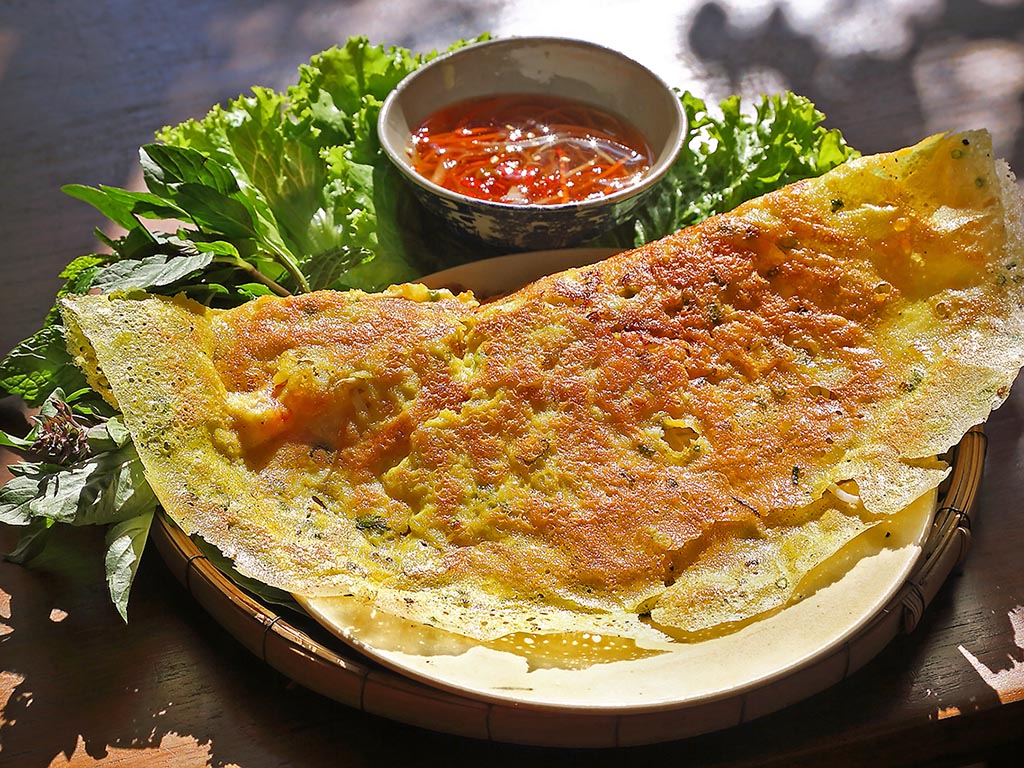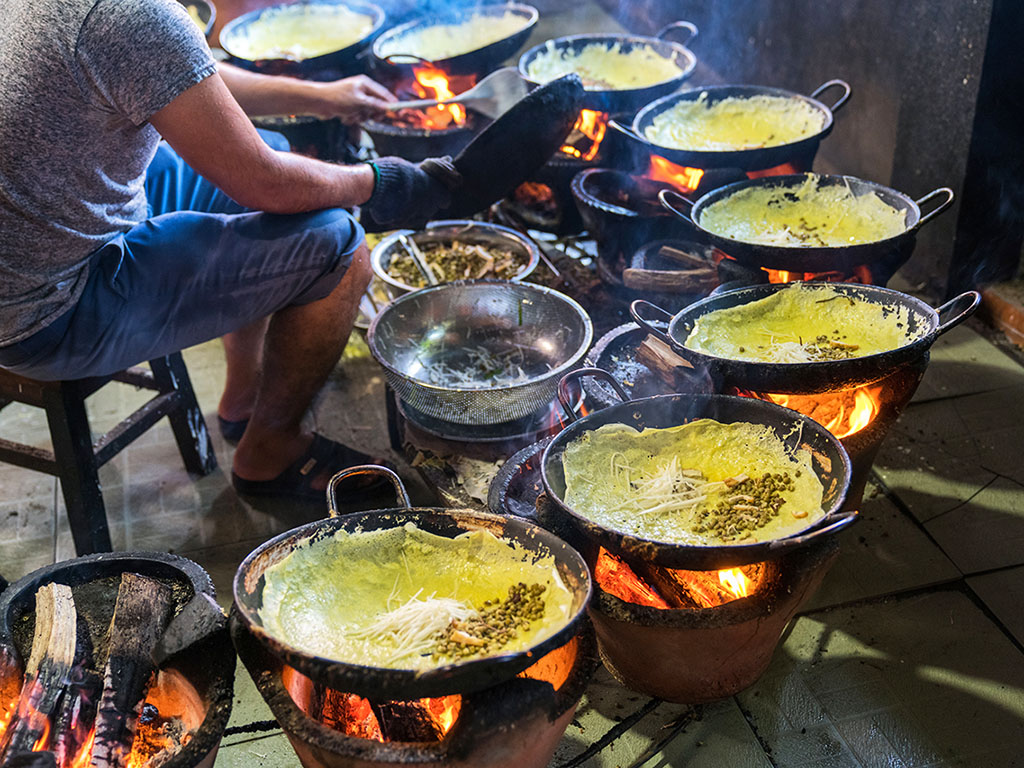What is banh xeo?
Banh xeo, also known as Vietnamese sizzling pancakes, is a traditional dish that is affordable for all walks of life. It is gaining popularity on the Vietnamese culinary map and is recommended as a must-try dish for anyone visiting the country. Although banh xeo can vary in shape and size depending on its origin, it generally strikes a perfect balance between yin and yang in its cooking and eating. We’ll guide you through its history and everything you need to know about this flavorful street food.
The origin of banh xeo
The history behind banh xeo is as fascinating as the dish itself. Have you ever wondered where the name “banh xeo” comes from? It is derived from an onomatopoeia that represents the sound of the batter sizzling as it is poured into a hot pan. The origin of banh xeo is a matter of debate, with some claiming it originated in Central Vietnam, while others believe it was adopted from Champa or South Indian cuisine. Despite its uncertain origin, banh xeo has captured the hearts of many food lovers, and at one point in history, it was even consumed as a substitute for rice on the 2nd and 16th of each month as a custom.

Types of banh xeo
Banh xeo, a popular street food in Vietnam, is known for its two distinct variations: Mien Trung (from Central Vietnam) and Mien Tay (from the Mekong Delta). Despite its popularity in the central and southern regions, it is not widely available in the North. A noteworthy aspect of banh xeo is its size, which tends to get larger as one travels further South. Additionally, the fillings can vary based on local ingredients, giving each city its own unique version of the dish.
1. Banh xeo Mien Trung
Banh xeo Mien Trung is as simple as the people who make it. In Central Vietnam, banh xeo is small, about the length of an adult’s hand. With limited fertile soil and a less favorable climate, there are not many ingredients to be found in the fillings. Usually, one banh xeo contains a prawn, a couple of thin slices of pork, and a generous amount of bean sprouts. In some coastal provinces like Binh Dinh and Quang Nam, you may find some squid added to it. Banh xeo is deep-fried, resulting in a crispy, slightly fatty texture. Although banh xeo Mien Trung doesn’t have an eye-catching yellow color, its ivory hue from rice powder is what sets it apart from other versions. Another unique characteristic is the addition of fermented shrimp paste (mam nem) to the sweet and sour fish sauce for dipping.
Typically, 2-4 pancakes are enough for one serving. Banh xeo Mien Trung is traditionally eaten in a small bowl. You take a piece of banh xeo, some herbs, add them to the bowl, top with the sweet and sour fish sauce, and enjoy. However, due to cultural integration, the central version can also be eaten as a wrap-and-roll dish. Simply ask for rice paper, place the ingredients in it, wrap it up, and dip it in the sauce.

2. Banh xeo Mien Tay
One distinct feature of banh xeo Mien Tay is its large size and varied stuffing, reflecting the relaxed and generous lifestyle of the southern people. In comparison to their central counterpart, Mekong Delta pancakes are double or even triple the size and much thinner.
With the advantage of a tropical monsoon climate and abundant agricultural produce, banh xeo Mien Tay offers a more diverse and flexible range of recipes. The batter is mixed with turmeric powder and coconut milk, resulting in a shiny yellow color and a creamy fragrance and aftertaste. The crust is thin and crispy on the edges but tender in the center. The filling includes pork belly, prawns, green beans, and jicama. In some localities in the Mekong Delta, such as Ben Tre and My Tho, banh xeo is made with different local ingredients. For example, they may use duck meat instead of pork as the main protein and add củ hủ dừa, the inner part of the top of a coconut only collected once in a coconut tree’s lifetime when it is cut down.
When served, pancakes are accompanied by a basket of green vegetables and herbs, including lettuce, Vietnamese basil, mint, fishy leaves, sliced cucumber, and pickled carrots. In the South, it is traditional to wrap the banh xeo crust with the fillings and vegetables, dip it in sweet and sour chili garlic fish sauce, and take a big bite.
These are not the only variations of Vietnamese pancakes you may encounter. There are no limits to the creativity of cooking, and the creation of banh xeo is no exception. So, we hope you embrace the banh xeo you come across and have a memorable experience with it.

Banh xeo ingredients
As mentioned, banh xeo is a simple and low-key dish for everyone, so it’s not surprising that the ingredients and cooking process are also accessible and affordable.
Many people mistake banh xeo for an omelet pancake, but it actually contains no eggs. The crust is made with fine rice flour, a teaspoon of turmeric powder, and a pinch of salt. Some suggest adding a bit of wheat flour or all-purpose flour for increased crispiness and a caramel-like color. Depending on personal preference, the batter can be mixed with coconut milk and chopped chives for added flavor and color.
The fillings typically include prawns and slices of pork belly as the main protein, while mung beans and bean sprouts add freshness. However, it’s possible to create your own version of banh xeo by adding different proteins, such as chicken, duck, or seafood, which all pair well with the dish.
Traditionally, banh xeo is fried in a cast iron pan over a wood fire, which is where the sizzling sound comes from. The cook starts by adding a cube of pork fat to the pan. Once melted, the batter is poured in and the chef quickly spreads it around before adding the pork, prawns, and vegetables. The pan is then covered for 3-4 minutes to cook both sides, after which the banh xeo is folded in half and placed on a plate lined with banana leaves. A successful banh xeo should be round, crispy, and yellow with a minimal amount of oil.
Making banh xeo is not just about the food, it’s also a cultural experience, with the sizzling noise, busy movements between pans, and irresistible aroma.
Note: Vegetarian versions of banh xeo are available at most restaurants by removing the meat from the recipe, but the taste of pork fat may still linger. It’s recommended to check if a restaurant offers vegetarian banh xeo or to opt for a vegetarian banh xeo restaurant, which will be suggested at the end of the guide.

How to eat banh xeo?
Banh xeo is meant to be a dish to be shared since making only one wouldn’t make sense and shared food is always better. To eat banh xeo, follow these steps:
Step 1: Tear banh xeo into bite-sized pieces.
Step 2: Place your preferred vegetables on top of a rice paper sheet.
Step 3: Use your hands or chopsticks to place a piece of banh xeo, including both crust and fillings, on top of the vegetables.
Step 4: Roll up tightly.
Step 5: Dip the roll in the chili garlic sweet and sour fish sauce.
Step 6: Place some pickled carrots from the sauce on top of the roll.
Step 7: Take a big bite and enjoy the explosion of flavor in your mouth.

Where to eat banh xeo?
As it was introduced, banh xeo caters to all palates and budgets. It can be experienced either on the streetside for your casual meals or in a fancy restaurant on a special occasion. Here is a list of our top picks for banh xeo concerning all needs and purposes:
Ho Chi Minh City
- Banh Xeo Nga
Address: 251 Nguyen Thien Thuat, District 1
Price: 72,000 VND (around $2.8) - Co Ba Vung Tau
Address: 40B Tran Cao Van, District 3
Price: 132,000 VND - Amitabha Restaurant (vegetarian)
Address: 40 Nguyen Thai Hoc, District 1
Price: 75,000 VND
Hanoi
- Banh Xeo Sau Phuoc
Address: 74 Cau Dat, Hoan Kiem District
Price: 18,000 VND – 90,000 VND - Son Lan
Address: 167 Doi Can, Ba Dinh District
Price: 12,000 VND – 60,000 VND
Da Nang
- Banh Xeo Mien Trung
Address: 14 Hoan Dieu, Hai Chau District
Price: 75,000 VND - Ba Duong
Address: 280/23 Hoan Dieu, Hai Chau District
Price: 80,000 VND - Quan Chay Thien Duyen (vegetarian)
Address: 308/8 Hoang Dieu, Hai Chau District
Price: 10,000 VND – 50,000 VND
Quy Nhon
- Gia Vi 2
Address: 14 Dien Hong, Le Hong Phong Ward
Price: 35,000 VND - Banh Xeo Tom Nhay
Address: 91 Dong Da, Thi Nai Ward
Price: 30,000 VND
Hoi An
- Co Anh
Address: 09 Thoai Ngoc Hau, Minh An Ward
Price: 35,000 VND - Quan An Hai Dao
Address: 160 Ly Thai To Street, Cam Son Ward
Price: 40,000 VND – 80,000 VND - Minh Hien Vegetarian Restaurant (vegetarian)
Address: 26/16 Thai Phien, Minh An Ward
Price: 49,000 VND
Hope you will enjoy banh xeo as much as we do!


